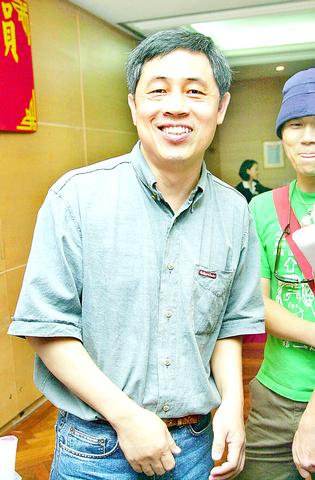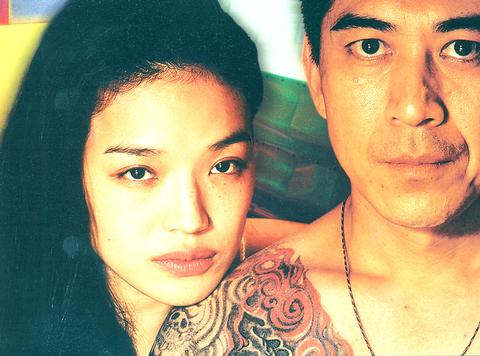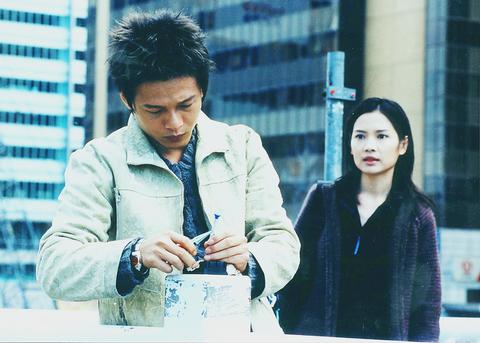A few years ago at an international film festival, Taiwanese director Wu Nien-jen (吳
Does the word `tu duu chih' mean `sound editing' in your language? The word is always seen at the credit roll."

PHOTO : WEI CHIA-CHIH, TAIPEI TIMES
Wu said that this was the name of a person -- it just happened that this person was virtually synonymous with sound editing in Taiwan.

PHOTO: FORTISSIMO
The man referred to was Tu Duu-chih (杜
This year at Cannes, Tu received the technical award for sound editing work on Millennium Mambo (千

PHOTO: HOME GREEN
"He has deserved the award for a long time now," said Hou, who directedMillennium Mambo.

PHOTO: CMPC
According to Hsiao Ya-chuan (蕭
A number of scenes in The Flowers of Shanghai centered on characters eating and drinking round a table. When the shot began, Hou would usually just say, "Okay, you can start now," and leave the actors to develop a situation through improvisational dialogue. "The recordist wouldn't know which lines spoken by which actor were the important ones," said Hsiao.
"The only thing you could do was to guess, and observe carefully," said Tu. "Sometimes you simply didn't catch anything to record, and the shot has to be made again," he said.
It is Tu's ability to work in the difficult circumstances of a Hou shoot that Hsiao, now a director in his own right, most admires about him. "It takes experience, intuition and courage to deal with that kind of situation," he said. "Having worked with Tu on my first short film, I have brought him in on all my other projects, if possible," Hsiao said.
Tu has always been in strong demand, and has been the sound editor for about 70 percent of Taiwanese films released since the mid-1980s.
One of Tu's major contributions to the Taiwan film industry has been the introduction of synchronized sound. The first such feature film in Taiwan to be shot entirely with sync sound was Hou's The City of Sadness (悲
In the 1970s and before, most Taiwanese films tended to focus on war, martial arts and family romance genres, in which sound was invariably dubbed. Even in the 1980s, when realism gradually became the cinematic mainstream, many films only had partial sync sound due to a shortage of technical personnel.
"Five years before the shooting of City of Sadness, about 20 years ago now, I began to work on the technique of synchronized sound recording," Tu recalled.
"At that time, a group of directors had recently returned from the US, and they gave me a chance to watch and learn during the post production process," Tu said of this period when he was an assistant in Central Motion Picture Corp's (CMPC) sound department.
"In the early days when we were making realist films, the boom poles we used for the mics were the kind of poles that people used to hang their laundry out on. The 32mm cameras we used were also very noisy, so they had to be covered with two to three blankets, so that after a few takes, the cameraman would emerge tired and sweaty," Tu recalled.
Tu's first use of sync sound was in a government project in conjunction with Edward Yang.
"The company assigned us a 16mm short film to promote a certain government policy. This was a great time to try the new technique [sync sound] -- even though we had to spend our own money to buy equipment."
After the success of City of Sadness, Hou bought a brand new set of sync recording equipment for Tu. "Hou thought the film was making money, and when he discovered there were bills still to pay, he'd already bought the equipment. So he had to take out loans to buy me the equipment, and I am still thankful for this."
With this new equipment, Tu began to work on more films using synchronized sound, taking the first steps to introducing this technique throughout the industry. "Now, only a couple of short films each year may not use sync sound," Tu said.
As a young man, Tu said, he loved stereos and so he looked for a job that dealt with the sound part of movies. "But later, I became fascinated by the use of sound in a movie context. This was when I fell in love with films, and the films of Hou Hsiao-hsien and Edward Yang in particular. From then on I endeavored to use sound to enhance the meanings they sought to express in their movies," Tu said.
Such is his commitment to cinema that even his memory is pegged to film. "I don't remember in what year my son was born. But I do remember that it was while I was working on Yang's A day on the Beach (海灘的一天).
Tu now has his own sound editing studio with a staff of eight that handles the sound editing for 90 percent of films made in Hong Kong and Taiwan. He himself is now currently associated with Chen Kuo-fu's (
But after 30 years of experience and a room full of prizes, his studio still failed to qualify for government subsidies supporting the local film industry. The reason is that he is only a studio, not a company.
"That's a bit funny but I don't care much," Tu said. "Doing a good job is more important to me. My greatest happiness is when a director tells me,`You make great sound.' I'm this kind of person."

April 14 to April 20 In March 1947, Sising Katadrepan urged the government to drop the “high mountain people” (高山族) designation for Indigenous Taiwanese and refer to them as “Taiwan people” (台灣族). He considered the term derogatory, arguing that it made them sound like animals. The Taiwan Provincial Government agreed to stop using the term, stating that Indigenous Taiwanese suffered all sorts of discrimination and oppression under the Japanese and were forced to live in the mountains as outsiders to society. Now, under the new regime, they would be seen as equals, thus they should be henceforth

Last week, the the National Immigration Agency (NIA) told the legislature that more than 10,000 naturalized Taiwanese citizens from the People’s Republic of China (PRC) risked having their citizenship revoked if they failed to provide proof that they had renounced their Chinese household registration within the next three months. Renunciation is required under the Act Governing Relations Between the People of the Taiwan Area and the Mainland Area (臺灣地區與大陸地區人民關係條例), as amended in 2004, though it was only a legal requirement after 2000. Prior to that, it had been only an administrative requirement since the Nationality Act (國籍法) was established in

With over 80 works on display, this is Louise Bourgeois’ first solo show in Taiwan. Visitors are invited to traverse her world of love and hate, vengeance and acceptance, trauma and reconciliation. Dominating the entrance, the nine-foot-tall Crouching Spider (2003) greets visitors. The creature looms behind the glass facade, symbolic protector and gatekeeper to the intimate journey ahead. Bourgeois, best known for her giant spider sculptures, is one of the most influential artist of the twentieth century. Blending vulnerability and defiance through themes of sexuality, trauma and identity, her work reshaped the landscape of contemporary art with fearless honesty. “People are influenced by

The remains of this Japanese-era trail designed to protect the camphor industry make for a scenic day-hike, a fascinating overnight hike or a challenging multi-day adventure Maolin District (茂林) in Kaohsiung is well known for beautiful roadside scenery, waterfalls, the annual butterfly migration and indigenous culture. A lesser known but worthwhile destination here lies along the very top of the valley: the Liugui Security Path (六龜警備道). This relic of the Japanese era once isolated the Maolin valley from the outside world but now serves to draw tourists in. The path originally ran for about 50km, but not all of this trail is still easily walkable. The nicest section for a simple day hike is the heavily trafficked southern section above Maolin and Wanshan (萬山) villages. Remains of